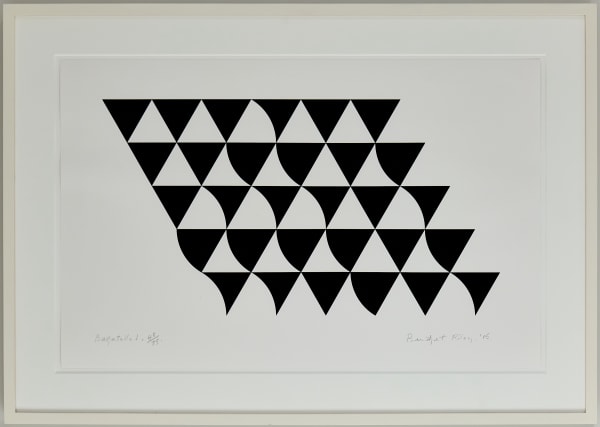Bridget Riley U. K., 1931
Bridget Riley is a British abstract artist widely associated with the Op Art movement of the 1960s. With striking clean lines, colour arrangements, and geometric precision she creates optically compelling visual effects. The artist's use of gradients and variations in tone stems from her admiration for the Pointillist Georges Seurat. “The eye can travel over the surface in a way parallel to the way it moves over nature. It should feel caressed and soothed, experience frictions and ruptures, glide and drift,” she said of her work. “One moment, there will be nothing to look at and the next second the canvas seems to refill, to be crowded with visual events.” Born on April 24, 1931 in London, United Kingdom, she studied at Goldsmiths College from 1949 to 1952 and the Royal College of Art from 1952 to 1955. In the following years, the artist began experimenting with the colour effects, leading her to the practice for which she is now known. Riley is often associated with other Op Art practicioners Victor Vasarely, Richard Anuszkiewicz, Frank Stella, and Ellsworth Kelly, among others.
Over the past decade, she has also made large, black-and-white murals that shape and articulate the environments they occupy. Her work is ultimately inspired by nature—“although in completely different terms,” she says, adding, “For me nature is not landscape, but the dynamism of visual forces—an event rather than an appearance.”She currently lives and works in London, United Kingdom. Her works are currently held in the collections of The Museum of Modern Art in New York, the National Gallery of Art in Washington, D.C., the Tate Gallery in London, and the Peggy Guggenheim Collection in Venice.
-
 Bridget RileyIntervals 3, 2021view more details
Bridget RileyIntervals 3, 2021view more details -
 Bridget RileyBagatelle 1, 2015view more details
Bridget RileyBagatelle 1, 2015view more details -
 Bridget RileyBagatelle 2, 2015view more details
Bridget RileyBagatelle 2, 2015view more details -
 Bridget RileyRose Rose, 2011view more details
Bridget RileyRose Rose, 2011view more details -
 Bridget RileyOne Small Step, 2009view more details
Bridget RileyOne Small Step, 2009view more details -
 Bridget RileyLarge Fragment, 2006view more details
Bridget RileyLarge Fragment, 2006view more details -
 Bridget RileyJune, 1992view more details
Bridget RileyJune, 1992view more details -
 Bridget RileyNew Day, 1992view more details
Bridget RileyNew Day, 1992view more details
-

Post-War/Modern
Art at the OWO 2024年10月8日 - 2025年1月31日Dellasposa Gallery is delighted to present a new exhibition at The OWO Residences by Raffles in London. This historic ve...继续 -

Lasting Impressions
2020年3月5日 - 5月1日Dellasposa Gallery presents original limited edition prints by Pablo Picasso, Robert Motherwell, Damien Hirst, Gerhard Richter, Bridget Riley, Anish Kapoor, Hiroshi Sugimoto, John Stezaker, Zhang Xiaogang, Darren Coffield, Dean + James, Ben Eine, Shepard Fairey, Cleon Peterson and Daniel Arsham.继续










